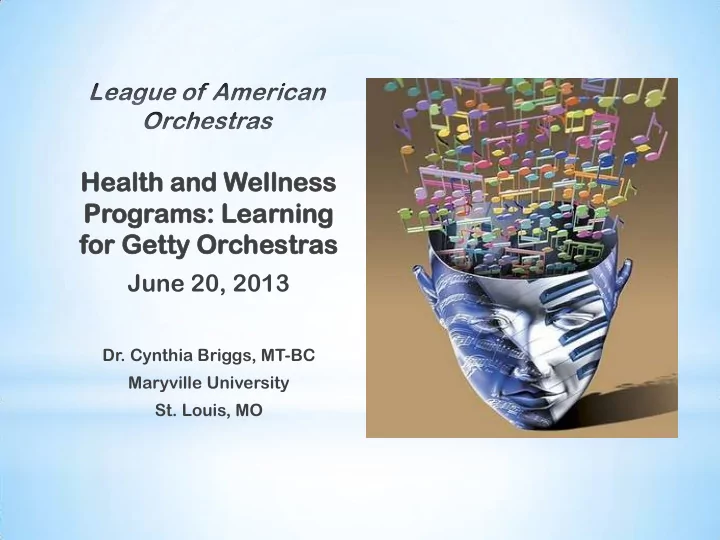

Health alth and Wellness ellness Prog ogram ams: s: Learning rning for Getty ty Orchestr hestras as June 20, 2013 Dr. Cynthia Briggs, MT-BC Maryville University St. Louis, MO
So why So hy is is m mus usic ic ther herapeutic? peutic? Music is learned and stored diffusely across the entire brain from brainstem to frontal lobe. The earliest sounds we make contain the elements of music: rhythm, phrasing, accent, tonality. Rhythm is an organizer, and driver: it directs motor movements and organizes musical and nonmusical content. Music is also processed by our auditory cortex and limbic system so it connects directly to our emotions and memories. We associate positive affects to the music we enjoy the same way we do with our favorite foods and people. We connect strong memories to music which are embedded in our memories along with the music - when we re-experience the music we re-experience the associated memories.
http://www.nytimes.com/2013/06/09/opinion/sund ay/why-music-makes-our-brain-sing.html?_r=0
Partnerships: Engaging other organizations with shared goals regarding the use of music in health and wellness programming Shared interests and goals Strengths of each partner organization Identification of needs Educating the partner members Ongoing listening Ongoing dialogue Post-op: reviewing regularly for evaluation and revision Self-evaluation and research
Shared interests and goals: What does each partner hope will be the outcome of this partnership in music and health? Is it realistic/ possible? Does each partner clearly understand what the other does and does not do? What does each partner need to be successful regarding their component of the partnership? Create shared goals for each project.
Identification of interests and needs: Survey the members of each partner – what are the member’s interests? What do partner members need to be successful? Educate all partner members about the project and what each partner organization does. Be sure the projects you create are need-driven.
Ongoing listening and dialogue: Initial surveys and dialogue regarding interests and needs become ongoing dialogue Listen/listen/listen! Partner members Program recipients The community
Self-Evaluation and Research: Build in ongoing self-evaluation procedures from the start Structure projects, when possible, so that there can be good data collection that can later lead to sharing of results Evaluate and learn from all of the data you collect, no matter what the level of the data is.
Recommend
More recommend